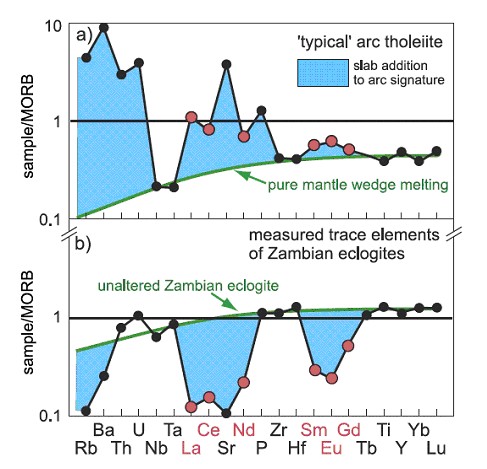 Web Content Display Web Content Display
Trace-element mobilization in subducting slabsINTRODUCTIONSubduction zones are the places on Earth where large mass transfer and element fractionation between crust and mantle occur. The agents, which are central to these processes, are aqueous fluids, supercritical liquids, or melts (e.g., Gao and Klemd 2005, Schmidt and Poli 2003, Plank 2005, Kessel et al. 2005). Many workers have postulated fluid flow out of subducting slabs to explain the characteristic enrichment of fluid-mobile elements relative to fluid-immobile elements in magmatic rocks from convergent margins. To better understand the origin of this arc signature, knowledge about fluid-rock interactions within the subducting slab and fluid flux into the mantle wedge is required. Here, we focus on the geochemistry of Zambian eclogites and associated gabbros, which represent relics of a fossil subducted oceanic slab. The main processes that transformed the Zambian gabbros to eclogites are fluid-controlled dissolution, transport, and precipitation, demonstrating the importance of fluid-rock interaction in low-T environments. Because the eclogites and gabbros are cogenetic and belonged to the same subducted plate (John et al. 2004), they provide an exceptional opportunity to study the influence of fluid-induced metamorphic processes on the bulk geochemistry of subducting gabbroic rocks and to evaluate the mobility of trace-elements. TRACE-ELEMENT SIGNATURESPrecursor gabbros were only transformed to eclogites if they were infiltrated by fluids under eclogite facies conditions (John & Schenk 2003). Hence, the eclogites represent relict fluid pathways. Many of the eclogites show depletions in LILEs (Rb, Ba) and LREE relative to unmetamorphosed gabbros, suggesting mobilization of these elements during fluid infiltration (Fig. 1). In contrast, typical island arc basaltic magmas are enriched in LREE as well as in LILEs relative to the immobile HFSE. Thus, these magmas have trace element signatures that are complementary to the Zambian eclogites, suggesting that fluids that have reacted with eclogite may be responsible for generating the slab component in arc magmas. CONCLUSIONSWe conclude that the transformation of dry, metastable slab gabbros to eclogites upon fluid-infiltration results in large-scale fluid transport of mobile elements to the sub-arc mantle. The observed degrees of fractionation LREE fractionation require high fluid-rock ratios. The lower gabbroic part of the oceanic crust is an unlikely source for such large fluid volumes, and thus it is likely that the fluid originated from the underlying serpentinized lithospheric mantle. The preferential mobilization of LILE over REE and LREE over HREE caused by an aqueous fluid strongly supports models that interpret elevated LILE/REE and LREE/HREE in arc volcanics as a fluid-related subduction component.
Fig. 1: MORB-normalized trace element patterns of "typical" arc tholeiite (a) and Zambian eclogite (b) show that several of the elements in the slab component of arc magmas have been removed from the eclogites by fluids. The LREE are highlighted in red (from John et al. 2004). |
 Events Events
Kieler Wissenschaftler fühlen den 'Puls der Erde' Wie funktioniert die Recyclingmaschine der Erde?Nach elf Jahren endet der Kieler Sonderforschungsbereich 574 zu Subduktionszonen Final colloquium of SFB 574 Teilprojekt ÖffentlichkeitsarbeitMEERESFORSCHUNG FÜR MICH UND DICH |
|
©SFB574 // Wischhofstrasse 1-3 // D-24148 Kiel // T. +49 (0)431 600 1413 // elange [AT] geomar.de






